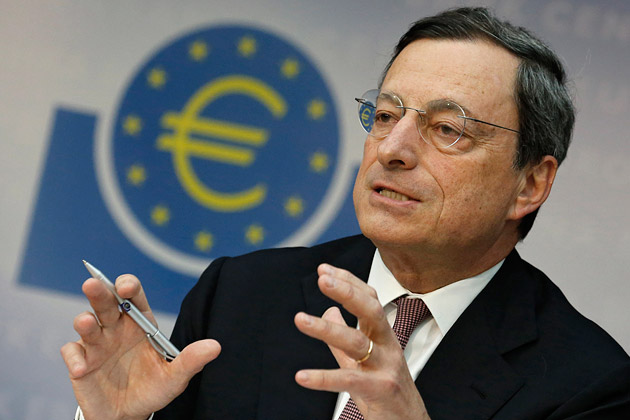Mario Draghi Takes Center Stage

Please note that we are not authorised to provide any investment advice. The content on this page is for information purposes only.
The ECB meeting or more precisely, the press conference, is the main event of the day, and possibly of the week and month. ECB President Draghi and Vice President Constancio have expressed heightened urgency to boost inflation as fast as possible. This has been countered by others arguing to give other new initiatives, including the second TLTRO (next week) a chance to work. Moreover, Bundesbank’s Weidmann has argued that the drop in oil prices will also provide stimulus that had not been counted on previously.
The ECB meeting or more precisely, the press conference, is the main event of the day, and possibly of the week and month. ECB President Draghi and Vice President Constancio have expressed heightened urgency to boost inflation as fast as possible. This has been countered by others arguing to give other new initiatives, including the second TLTRO (next week) a chance to work. Moreover, Bundesbank’s Weidmann has argued that the drop in oil prices will also provide stimulus that had not been counted on previously.
However, there are five other developments to note today. First is the price action. The major currencies are in narrow trading ranges against the dollar today. The euro has been confined to 15 bp on either side of $1.2310. The dollar has been confined to less than a quarter of a yen below JPY120. Sterling has enjoyed a somewhat wider range of 40 pips, but is trading within yesterday’s ranges. It remains within the range seen Monday over the last three sessions.
Although there are some who expect Draghi to give clear commitment that sovereign bonds will be purchased next year or sooner, given the rally in European bonds and stocks and the decline in the euro, there seems to be recognition of the risk of disappointment. Many want to sell into the euro bounce.
Second, although the Hong Kong-Shanghai equity link is off to a rather slow start, Chinese stocks are on a tear. The Shanghai Composite is up 4.3% today and 10.25% over the past five sessions. It has gone parabolic, rallying 18.6% over the past eleven sessions. It now sits at a fresh three-year high. Among the key drivers is the anticipation of easier monetary policy. Not only did the PBOC unexpectedly deliver it first interest rate cut in two years, but more action is expected.
That the PBOC failed to drain liquidity for the past three sessions has encouraged speculation of a cut in reserve requirements as early as tomorrow. In addition, reports suggest that officials will soon allow wealth management products to trade on the bond and stock markets, disintermediating the trust banks, and further squeezing shadow banking activity.
Third, the Nikkei rose nearly 1% to a new seven-year high. The weaker yen helped, but the market also appears encouraged by a series of newspaper surveys showing that rather than lose seats as appeared to be the case, the LDP may gain in the December 14 snap election. The polls consistently show the LDP could pick up six seats to give it 300 of the 475 seats in the Diet. The junior coalition partner, Komeito can retain its current 31 seats.
The combination would give the coalition 331 seats. This is a super-majority, guaranteeing the government the ability to push through its agenda, which includes controversial measures regarding defense, the constitution and nuclear power. However, in many ways this would simply reaffirm the status quo. In the current Diet, the governing coalition has a super-majority.
We are somewhat suspicious. Abenomics in not very popular and what is often not picked up in the foreign press is that the opposition parties are coordinating activity in many of the constituencies. Voting in the lower house election is a bit more complicated than many may be aware. A Japanese voter casts two ballots: The first is for the representative of the constituency. There are 295 such constituencies. The second is for the party for the proportional representation. There are 180 such seats. Lastly, we note that turnout is also key. A low turnout seems to favor the LDP. In 2012, when the LDP won, it received fewer votes than when it was defeated by the DPJ in 2009.
Fourth, stronger than expected Australian retail sales and a smaller current account deficit failed to stem currency rot. The Australian dollar has extended its losses and pushed to almost $0.8355. The October retail sales rose 0.4% compared with expectations of a 0.1% gain. This follows the 1.3% rise in September (initially 1.2%). The October trade deficit was a third smaller than expected at A$1.3 bln, while the September deficit was revised smaller. Exports were up 2%, while imports fell 2%. The key to the Aussie’s performance appears to be the shifting expectation, or conviction, that the RBA will deliver rate cuts next year.
Fifth, the combination of US economic data, Beige Book, and comments from Fischer and Dudley underscore the divergence theme that is seen benefiting the US dollar (on a trend basis). Just like the Bank of Canada indicated that they would look past what it says are temporary factors boosting inflation, the idea is that the Fed leadership is signaling it will look past the disinflationary impact of the fall in oil prices.
Five Things to Know Ahead of the ECB Meeting is republished with permission from Marc to Market




